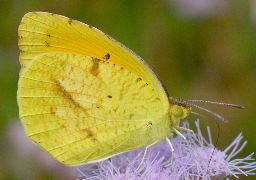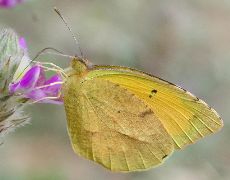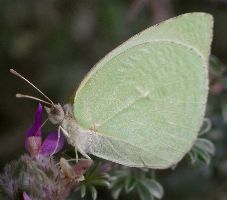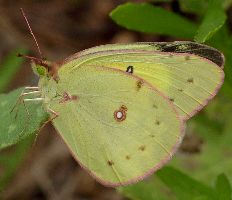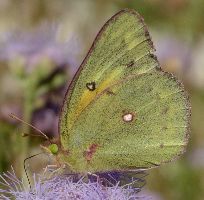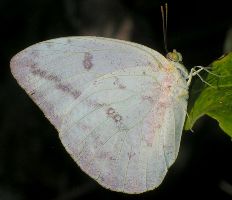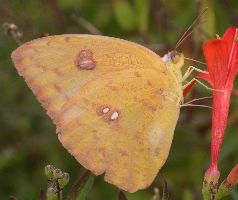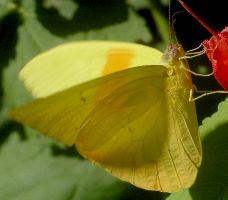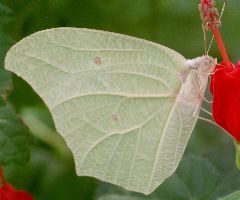
| Pieridae ~ Whites, Sulphurs |
page 1 ![]() page 2
page 2
|
During the latter part of the summer and well into fall, one of the most common sulphurs is the Little Yellow (Eurema lisa). The males are a bright lemony yellow while females are paler or even white. They have a slightly scalloped edge to their wings, with black dots, but these lovely ornamentations often wear off quickly. The undersides of the wings are marked with scattered single black scales as well as dark blotches. There is usually a rust-colored round blotch on the top of the hind wing. In the late autumn I often find these butterflies resting amidst the fallen yellow leaves in our yard, and they are almost invisible until they fly.
Another species of similar size is the Sleepy Orange (Eurema nicippe). In the summer this butterfly is bright yellow, but those that emerge during the winter are often so dark that they look brownish orange. The underside of the hind wing is the most affected by this color change and the butterflies often rest with the forewings folded down behind the hind ones. The result is that they look like a dead leaf. The distinguishing features of the Sleepy Orange are the shape of the hind wing, which has a slightly concave area in the lower outer corner, and the brownish markings that include a pair of diagonal slashes on the hind wing.
An uncommon stray into our area is the Mexican Yellow (Eurema mexicana). Its wing coloration is very similar to the Sleepy Orange, with a brown marked hind wing and slash marks. However, this species is larger and has very pronounced sharp angle on the hind wing.
One other occasional visitor to our area is the Lyside Sulphur (Kricogonia lyside). Although this butterfly has light yellow on the tops of its wings, as with most sulphurs, they are rarely seen except when in flight. The underside is a greenish white, and there is a prominent white vein clearly visible in the middle of the hind wing.
The Orange Sulphur (Colias eurytheme) is one of the more common medium-sized species here. Its wings are orange on top, but yellow on the underside. Females can be white, but most are just a duller yellow color. During warm weather, the undersides of the wings are light yellow, but individuals that hatch during colder months tend to be darker, and their bodies are even hairier.
Another butterfly of about the same size and frequency of sightings is the Southern Dogface (Colias cesonia). This species is easily distinguished by the points on its forewings and the black markings on the tops of those wings that show through on the underside. When viewed from the side, they look like a cartoon dog face facing to the rear, with a strong black dot for the eye. Because of variability, the resemblance to a dog profile is sometimes left up to one's imagination. The wings are often marked with pink, especially on the edges and along veins. This coloration becomes much more prominent in the autumn. Our largest sulphurs are in the genus Phoebis. These big yellow butterflies always look quite large as they slowly flutter about. The Large Orange Sulphur (Phoebis agarithe) ranges from orange to yellow, with some females being white with a pinkish tinge as they get more worn. The best way to identify this species is by the distinct complete diagonal line on the forewing. This same line on other Phoebis species is broken up.
Another Phoebis that shows up occasionally is the Orange-barred Sulphur (Phoebis philea). This species is rather variable and hard to separate from the Cloudless Sulphur. Females, though, tend to be more orange in color, with heavier mottling on the underwings. Males can be nearly clear and bright yellow on the underside, but they do have an orange bar on the top side of the forewings.
The Cloudless Sulphur (Phoebis sennae) is by far the most common species in this group. They are often a pale yellow color with only small scattered markings on the wings. Females usually have more markings and can vary in color from white to yellow. While they are large, this species is a bit smaller than the previous two.
A very large white butterfly that shows up only rarely is the White-angled Sulphur (Anteos clorinde). The distinctive shape and the numerous swollen veins on the undersides of the wings make this sulphur easy to identify. |
page 1 ![]() page 2
page 2
![]()


